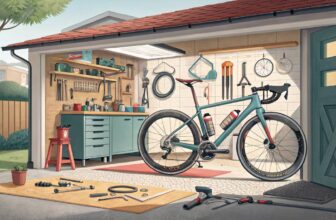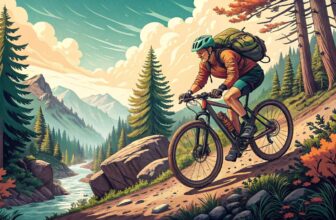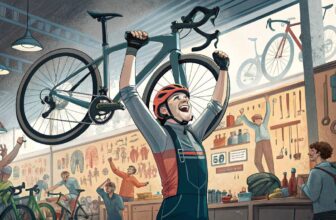Consider Before Buying
Bike Types Comparison
Thinking about getting a bike? Let’s break down the options so you know what suits you:
| Bike Type | Description | Pros | Cons |
|---|---|---|---|
| Road Bike | Built for speed with lightweight frames, often carbon fiber. | Zippy, smooth, ideal for long hauls. | Can cost an arm and a leg, not the best for relaxed rides. |
| Hybrid Bike | The love child of a road bike and a mountain bike. | Cozy, adaptable, shines in city life. | Bulkier than road bikes, not a speed demon. |
Curious about where to snag a bike? Or eyeing the best bang for your buck? Our bike price guide is your friend.
Component Differences
What’s under the hood matters. A bike’s bits and bobs make or break its mojo:
- Brakes: Disc brakes are all the rage. Quick stops and good when Mother Nature’s in a mood, though they’ll cost your piggy bank more and need some TLC.
- Shifters and Derailleurs: Road bikes flaunt top-tier parts for buttery smooth gear changes, but heads up—they don’t come cheap.
| Component | Road Bike | Hybrid Bike |
|---|---|---|
| Shifters | Sleek and precise | Rugged and ready |
| Brakes | Disc or dual-pivot | V-brakes or basic discs |
| Frames | Carbon fiber or aluminum | Aluminum or steel |
For a deeper dive into component nitty-gritty, check out our bike component comparison guide.
Handlebars and Pedals
The steering wheel and foot gear—handlebars and pedals—are game-changers for how a bike feels:
- Handlebars: Hybrids sport flat bars, keeping your ride steady as you go. Perfect for newbies. Road bikes, however, come with drop bars for those who want to go full turbo and switch up hand positions—though might feel a bit tricky for beginners.
- Pedals: Basic flat pedals or fancy clipless ones, it’s all up to your comfort level and experience.
Knowing the above can help you dodge common oops moments while buying a bike. For more wisdom on picking the perfect bike, don’t skip our articles on bike frame sizing and how to test ride a bike.
Brakes and Maintenance
Thinking about those all-important brakes is key, whether you’re new to biking or have been on two wheels for years. Getting a grip on how they work can save you from common bike buying blunders and keep your rides safe and smooth.
Disc Brakes vs. Rim Brakes
Brakes are the boss of bike parts, deciding just how chill or thrilling your stops are. Let’s dig into the two big contenders: disc brakes and rim brakes.
Disc Brakes
Disc brakes are the superheroes of stopping power—no cape needed. They grab onto a rotor fixed to the wheel hub, so even rain can’t put a damper on their performance. This means less “oops” and more “awesome” when you need to stop in a hurry. Cyclists love them for their reliability. Sure, they might cost a bit more and crave regular TLC compared to rim brakes, but you get what you pay for.
| Brake Type | Stopping Power | Weather Performance | Cost | Maintenance |
|---|---|---|---|---|
| Disc Brakes | High | Awesome | Higher | Needs Love |
| Rim Brakes | Moderate | Weather Moody | Friendlier | Low-key |
Rim Brakes
Old-school charm and simplicity are the name of the game with rim brakes. They clamp onto the wheel’s rim to slow you down, making maintenance as easy as pie. While they’re kind to your wallet and a breeze to look after, rainy days might make them a bit shy, stretching your stopping distance.
Choosing your brakes boils down to what you can spend, how and where you ride, and how much attention you want to give them. Checking out bike component comparisons could be your ticket to the best pick.
Importance of Regular Tune-ups
Keeping your bike in top shape means regular tune-ups are non-negotiable. Maintaining it well keeps you rolling smoothly and safely while keeping costly repairs at bay.
Here’s where you should focus:
- Brake Check: Give those pads and cables a once-over on the reg. Swap them out when they start looking shabby.
- Chain Love: A greasy chain makes for easy shifting and keeps your gears happy.
- Tire TLC: Pump tires to the sweet spot before every ride, and keep an eye on the tread for grip.
For a roadmap to all things bike care, check out our bike maintenance plans.
| Maintenance Task | Frequency |
|---|---|
| Brake Check | Monthly |
| Chain Love | Every couple of weeks or post-wet rides |
| Tire TLC | Pre-ride |
| Full Tune-up | Twice a year |
Sticking to a solid maintenance routine keeps your bike rolling for the long haul and turns your rides into something to smile about. Know your bike warranty guides inside out so you’re ready for any curveballs life throws your way.
Bike Fit Evaluation
Nailing the right bike fit means you’re a winner when it comes to comfort and getting the most out of your ride. Who wants to wrestle with aches and pains because of a wonky setup? Not you! Avoid those rookie bike buying mistakes and make every ride a breeze.
Bike Fit Assessment
Checking yourself out on a new set of wheels? It’s not just about hopping on and hoping for the best. Measuring up includes checking how your arms, legs, and posture fit into the whole picture. A wrong fit spells discomfort city and wastes your energy like nobody’s business. So maybe spend some time with the bike maker’s guidelines or a bike size calculator to gauge what’ll work.
| What to Measure | Why It Matters | Where to Read More |
|---|---|---|
| Inseam Length | Matches you up with the right size frame | Cyclists Hub |
| Arm Length | Dictates how far you can reach those handlebars | The Pro’s Closet |
| Leg Length | Helps set your saddle to spot-on height | The Pro’s Closet |
Trying an at-home check? Why not give it a shot? Here’s what to look for:
- Posture Check: Keep that spine straight and hips squared while sitting.
- Pedaling Mechanics: Look for smoothness as you pedal away.
- Strength Evaluation: Check if any side is weaker and causing an imbalance.
Pairing these pointers with a bike frame sizing guide can lead you to bike-fit glory.
Strength and Mobility Checks
Cycling isn’t just about leg power. It’s a full-body shindig! Sometimes a tweak to your own fitness game beats adjusting the bike. Exercises that boost your muscles can make those rides a ton more fun and comfy.
Consider these muscle areas:
- Core Muscles: A solid core keeps you steady and limits bouncing in the saddle.
- Leg Flexibility: Giving your legs the freedom to move pumps up pedaling power.
- Upper Body Mobility: Keeps any shoulder and neck grumbles on long spins away.
Weakness can show up as squirming on the seat, leading to drained energy. Following a routine of stretches and strength moves can kick these issues to the curb and get you riding right.
Bringing together a thorough bike fit check with muscle workouts means you won’t trip up on common bike buying goofs. For more fun facts on picking a bike, stop by our how to test ride bike guide.
Common Mistakes
Choosing the Wrong Size
Picking a bike that’s not your size is like wearing shoes that don’t fit—uncomfortable and possibly harmful. Make sure the bike suits your inseam length by checking a size chart. Many folks discover too late that their bike isn’t right for their favorite paths or riding habits. Avoid this bummer by using tools like our bike size calculator and following our bike fit assessment guide.
| Metric | Value |
|---|---|
| Ideal Bike Size (cm) | 49 – 60 |
| Inseam Length (inches) | 28 – 32 |
| Frame Size (number) | S, M, L |
Focusing Too Much on Components
Getting fixated on a shiny part like a rear derailleur can be a trap. A top-notch derailleur doesn’t mean everything else on the bike is just as good. Check the full specs to see what you’re getting. Our bike component comparison tool will help you avoid surprises.
| Component | Example Models |
|---|---|
| Rear Derailleur | Shimano 105 |
| Front Derailleur | Shimano Tiagra |
| Crankset | SRAM Rival |
New vs. Used Bikes
Brand new isn’t always better, especially for newcomers on a budget. Used bikes can be wallet-friendly, lower your depreciation worries, and give you wiggle room for upgrades. Our new vs used bike guide can guide you through the decision. When checking out a used bike, keep in mind:
- Inspect the frame for cracks or dents (used bike inspection)
- Look for excessive wear on parts
- Check if it has necessary accessories like lights and pedals
For more tips, particularly for beginners, check out our bike buying mistakes article. Here’s the lowdown on what to consider for used bikes:
| Category | New Bike | Used Bike |
|---|---|---|
| Cost | High | Lower |
| Depreciation | Rapid | Reduced |
| Accessories | Often have to buy | Usually included |
Avoid these common pitfalls, and your bike-buying journey will be a breeze, leaving you ready for the open road. For more help, see our bike price guide and where to buy bikes pages.
Accessories and Future Needs
Importance of Accessories
Alright, folks! If you’re new to cycling, don’t underestimate the power of the right gear—they can turn your ride from “meh” to “whee!” Setting aside some moolah for top-notch accessories and snazzy apparel is key. We’re talking essential items like helmets, shoes, sunglasses, and those fancy bib shorts. Think of them as your ticket to comfy, joy-filled rides.
Here’s your gear checklist:
- Helmet: Your noggin’s bodyguard. Seriously, it’s gotta stay safe.
- Shoes: Gives you that extra pedal power. Grip it, rip it.
- Sunglasses: Because riding with squinty eyes ain’t fun. Defense against the sun, dust, and wind.
- Bib Shorts: Trust us, your backside will thank you on those long hauls.
- Lights: See and be seen on those nocturnal rides.
Future-Proofing Purchases
So, you’re ready to snag a bike? Before you whip out your wallet, think about not just today’s thrill but tomorrow’s adventures too. Scoring a bike that works for now and later means less cash down the line. Because, let’s face it, your cycling ambitions are likely to change. Go for one that’s versatile enough to keep up with your riding evolution.
Why Future-Proof?
- Flexibility: One bike, multiple styles of cycling.
- Save Money: Dodge the expense of constant upgrades.
- Better Resale: Bikes with more capabilities often fetch higher resale prices.
And for newbies ballin’ on a budget, a certified pre-owned (CPO) bike is a savvy pick. Don’t stress—used bikes offer a sweet deal by skipping the hefty depreciation of new ones, so no crying over tiny paint scratches. Plus, they’re easier to upgrade or sell, thanks to slick programs like Guaranteed Buyback.
Want more info on the great debate of new vs used bikes? We got the goods right here.
Keep these nuggets in mind to dodge those common bike buying blunders and pedal towards an epic cycling quest!




